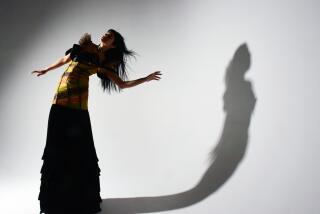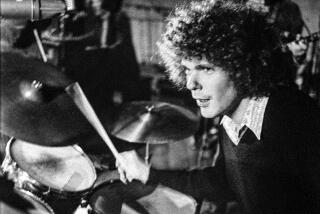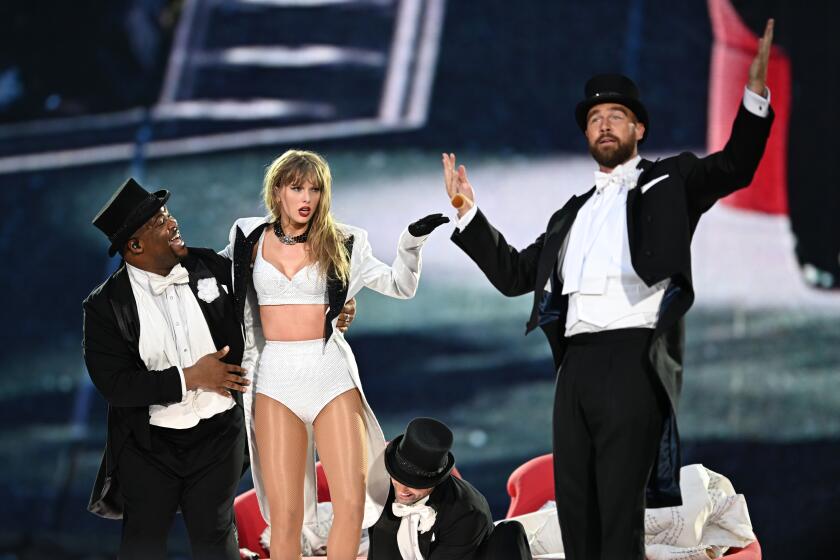Live review: Mary J. Blige and D’Angelo at the Gibson Amphitheatre
When D’Angelo sat at his electric piano Sunday night at the Gibson Amphitheatre and played the first bars of his hit “Untitled (How Does It Feel),” women screamed with Pavlovian memories of the song’s video, which starred his oiled abs, pelvic muscles and, it’s rumored, the rest of the singer as well. Grown men leaped to their feet and yelled, “Give ’em more, D!” like they were cheering an action-movie hero.
But then D’Angelo stopped. He walked out from behind the piano, stood before the crowd and waited. He stayed there for a full minute while the cheers grew ravenous and maybe even a little threatening — someone shouted, “Oh, no, that can’t be it” as if they intended to make him finish.
D’Angelo soon returned and brought the house down with “Untitled,” a song he famously neglected to play at his recent House of Blues comeback date. But he’d made his point. D’Angelo has a dicey relationship with the song that made him a star — a single that foisted a sex-god stereotype upon him, an image that does no justice to his complex musicality.
PHOTOS: D’Angelo, now and then
That question — how does a singer riff off the early material that made his or her reputation? — drove the Liberation tour, which also starred headliner Mary J. Blige and younger singer Melanie Fiona. The two top acts had opposite ways of solving that problem, and their sets were profoundly rewarding for it.
After a decade-long public disappearance marked by substance abuse and erratic behavior, D’Angelo finally returned to the public eye this year with a small run of dates that proved his virtuosity had never left. His 2000 album, “Voodoo,” is rightly regarded as a modern classic, where the incandescent soul of Al Green and Marvin Gaye is steeped in a witchy brew of atmospherics and Prince-ly musicianship.
Given his long detour out of touring and recording, his two-album studio catalog is slimmer than it might have been. But his return has underlined just how incredible those albums are. His quiet-storm ballad from 1995’s “Brown Sugar” — one with an unprintable but perfectly forthright title — got right to the perennial doomed-romantic’s question of “Why are you sleeping with my woman?” “Lady” and “Cruisin” pretty much shame today’s class of classless dance-floor Casanovas.
He offered hints of new work from the long-awaited follow-up to “Voodoo.” One standout in particular with a working title of “Sugar Daddy” rounded a bend into straight James Brown funk that would have no peer on radio, should it come out soon.
Blige, in contrast, has released a new album about every two years since 1992. The most recent of which is a sequel to her creative high watermark, 1994’s “My Life” (that latter was loaded with stories of abuse, addiction and emotional strafing).
“My Life 2…The Journey Continues (Act 1)” could seem like a sign of a creatively tapped artist resuscitating an older, more vital work. And although the record doesn’t quite live up to its namesake, at the Gibson, Blige took the whole of her catalog and made it a wrenching yet totally danceable narrative.
For all her reputation as an emotionally wracked Cassandra of romantic truth, cuts such as “Family Affair” and “Enough Cryin” still kick harder than all the revivalist producers rediscovering her peak work.
But she shined on ballads, where she used her unmatched power to let a huge song devastate and redeem her. “Empty Prayers,” from “My Life 2,” is one of the best in her catalog, one haunted by Ellie Greenwich and Whitney Houston alike.
When the chorus of “You left me on my knees, you just walked out the door” landed, in another Brown twist in the night, it actually brought the singer to her actual knees for several seconds until, finally, she rose to conquer it.
Earlier, in a fit of inspired righteous screaming, she swore that “you can’t keep a good woman down.” Her rise was a promise fulfilled.
ALSO:
PHOTOS: D’Angelo, now and then
Pop music review: D’Angelo in the here and now
PHOTOS AND MORE:
PHOTOS: Iconic rock guitars and their owners
PHOTOS: The Rolling Stones at 50
John Cage, radical composer for the 20th century
More to Read
The biggest entertainment stories
Get our big stories about Hollywood, film, television, music, arts, culture and more right in your inbox as soon as they publish.
You may occasionally receive promotional content from the Los Angeles Times.







